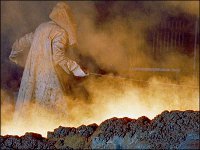
 It's perhaps no accident that a fascination with postwar Britain (until relatively recently, something of an historical no-mans land) has been growing under ever-darkening shadows of modern economic uncertainty. The documentary films of postwar Britain, a land well within living memory which is both recognisable and alien, are some of the most vivid evocations we have of boom and of bust, and of much that arose in between the two. Some of the themes defining our times suffuse these films: the relationship of state, society and the individual; the benefits of technology and its costs; what it means to live the 'rich life'. Their subject-matter has its limits, and so do their viewpoints - indeed they are a good gauge of what constituted social consensus at the time they were produced. But what they can convey they convey compellingly.
It's perhaps no accident that a fascination with postwar Britain (until relatively recently, something of an historical no-mans land) has been growing under ever-darkening shadows of modern economic uncertainty. The documentary films of postwar Britain, a land well within living memory which is both recognisable and alien, are some of the most vivid evocations we have of boom and of bust, and of much that arose in between the two. Some of the themes defining our times suffuse these films: the relationship of state, society and the individual; the benefits of technology and its costs; what it means to live the 'rich life'. Their subject-matter has its limits, and so do their viewpoints - indeed they are a good gauge of what constituted social consensus at the time they were produced. But what they can convey they convey compellingly.
Such films were made in their thousands and seen by millions (sometimes in cinemas and on television, but with the 'non-theatrical' circuit as the basis of their distribution). Yet rediscovering them, as more than sources of stock footage, means challenging the standard accounts of documentary film history. This entire generation of filmmakers, who took up the baton from the documentary movement of the 1930s and 1940s to make documentaries for the large screen, is strangely absent from almost all these accounts, which devote much space to debating that earlier movement. Received wisdom has been that British documentary went into swift decline after World War II, resurrected only by Free Cinema and the arrival of television documentary. Partly, this is because (a handful of independent productions aside) the majority of the films were made under sponsorship from the state, the voluntary sector and above all from industry. Hence their thematic limitations, in contrast especially with the television documentary as it grew in confidence. Sponsorship - judged progressive in the 1930s - now fell sharply out of fashion with critics, especially politically-minded ones.
In fact, though, this is one of the very fascinations of the films: the spectacle of institutions from public bodies to multinational industries embracing the documentary film medium in postwar Britain as in no other country before or since, all of them in distinct ways. Amid hundreds of sponsors, major sectors included: government departments via the Central Office of Information; public bodies such as the GPO, the Gas Council and, fascinatingly, the British Productivity Council; nationalised coal and transport industries coal; and such capitalist concerns as Shell, BP and other oil companies, ICI, Unilever and Ford. Many of these employed 'films officers' to set their policy for the medium and to act as vital intermediaries between head office and the creatives.
Production of the films was divided between 'in-house' film units located inside their sponsoring bodies - the most prestigious examples being British Transport Films and the Shell Film Unit - and a growing independent sector. The largest production group was the Film Producers Guild of companies including Verity Films, Greenpark Productions and Technical and Scientific Films. Meanwhile the largest standalone company was World Wide Pictures - founded in 1942 and still in business today. Other firms had roots in the earlier 'movement' - like Basil Wright's Realist Film Unit and Data Film Productions, Britain's first film co-operative and a fascinating (though ultimately failed) attempt to keep socialist ideals alive in documentary filmmaking. Not to be forgotten are the companies associated with producer Leon Clore, especially Basic Films and Graphic Films, providing haven for Free Cinema but also for creative filmmakers outside that short-lived movement. Later companies bringing a youthful freshness to the scene included Derrick Knight & Partners, and Anne Balfour Fraser's Samaritan Films. The contrasts between these producers' aims, house styles and client rosters adds another layer of fascination to this neglected period. Then there are the filmmakers themselves. While this was not a field particularly conducive to 'auteur' filmmaking in any purist sense, it did allow for a range of temperaments. Thus, many directors are worth rediscovering, either in their own right or as examples of wider trends.
The 'social documentary' and the 'industrial film' were the yin and the yang of sponsored filmmaking. Paul Dickson early on, Derrick Knight in the 1960s, and John Krish and Sarah Erulkar throughout the period, are examples of filmmakers who excelled with their fresh coverage of human subject-matter, sponsored most often by government and charities. Meanwhile, directors who thrived under industrial patronage also had much more varied styles and subjects than might be expected. Filmmakers who benefited from oil sponsorship, in particular, included Peter de Normanville, Michael Clarke, Alan Pendry, John Armstrong and Derek Williams. Most of these directors have a thoughtful style, even extending in some cases to sincere (if debatable and arguably compromised) studies of environmental issues. Conversely, such notable beneficiaries of funding from industry as James Hill, Eric Marquis and Geoffrey Jones had positively flamboyant directorial personalities.
Even the young Lindsay Anderson found his way to making professional films thanks to his association with the Sutcliffe conveyor belts firm in West Yorkshire. It was not just in 'Free Cinema' that maverick filmmakers were to be found. Individuals like Anthony Simmons, Guy Brenton, Michael Orrom, and to some extent Knight, kept one foot in sponsored filmmaking while also seeking - with varied success - to raise funds for personal projects. There is no denying that this period in documentary filmmaking was one in which potential was as often thwarted as it was fulfilled. Yet in many ways, it is all the more fascinating to study the relationship between such varied personalities under the constraints basic to their industry at the time. Varied though they are, this was a generation with several things in common. They inherited the earlier documentary movement's command of cinema craftsmanship, while bringing to it postwar sensibilities alien to the earlier films. They further had in common the practical challenges of managing a career and of reconciling their motives with those of their funders: all of which should be taken account of when judging their films. They shared an unmistakeable love of their medium - of cinema. Perhaps most refreshing, their works, generally, reveal a profound lack of cynicism.
RELATED VIDEO











